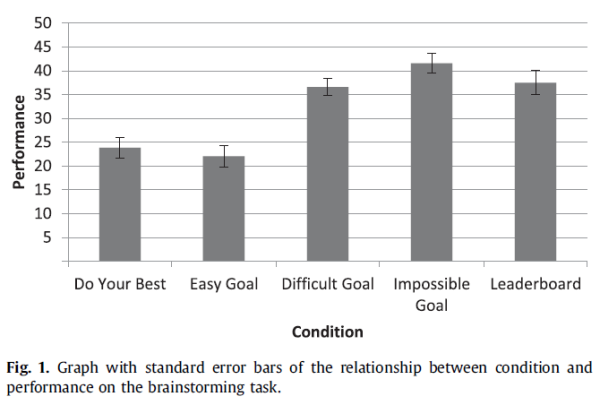Gamification Works a Lot Like Goal-Setting
![]() One of the most common forms of gamification is the use of leaderboards. Despite their bad press, leaderboards are commonly used to direct people to achieve specific target goals while motivating them via competition. You see that leaderboard, and you need to score highly on it! Leaderboards are sometimes derided as being poor examples of gamification, yet research seems to support them as effective tools, at least in some circumstances.
One of the most common forms of gamification is the use of leaderboards. Despite their bad press, leaderboards are commonly used to direct people to achieve specific target goals while motivating them via competition. You see that leaderboard, and you need to score highly on it! Leaderboards are sometimes derided as being poor examples of gamification, yet research seems to support them as effective tools, at least in some circumstances.
In organizational science, we already have a technique to give people goals: goal-setting! Goal-setting, without leaderboards, is quite effective at directing employee behavior. If give an employee a specific, measurable, attainable, realistic, time-bound (SMART) goal, that employee is more likely to achieve that goal than if you let them just try their best.
That leads to a bit of a problem if you’re planning a motivational intervention for your employees. Which would you expect to be more effective: a leaderboard or goal-setting theory?
In a recent study by Landers, Bauer and Callan1, this was tested by experimentally assigning people to one of five brainstorming conditions. In four, participants experienced classic goal-setting stimuli – do-your-best, easy, difficult, and (nearly) impossible goals. In the fifth, they experienced a leaderboard with all of those goals but represented in point form – so for example, the top score on the leaderboard corresponded to the “impossible” goal.
Importantly, goal-setting theory tells people to try to reach a goal. So in the difficult goal-setting condition, participants were instructed to try for the difficult goal. In the leaderboard condition, they were not instructed at all – there was simply a leaderboard present.
So how did participants do? Simply presenting the leaderboard resulted in similar achievement levels to those of the difficult and impossible goals.
Thus, simply presenting a leaderboard motivated participants to strive for the top of the leaderboard, at the same level as difficult and impossible goal-setting. This demonstrates a great deal of value for gamification – instead of simply commanding your employees with specific goals, presenting those goals on a leaderboard could have a similar effect.
Importantly, goal commitment was important for the leaderboard just as it is for goal-setting. In goal-setting, you need to believe in your goal. You need to think that it’s a worthwhile goal to pursue. Leaderboards appear to work the same way – you need to believe those scores are worth pursuing. However, from the research presented it here, it appears that this commitment is even more important for leaderboards. People who did not believe in the leaderboard performed worse than those in the impossible goal-setting condition, whereas people who did believe in the leaderboard performed better than the impossible goal-setting condition.
Thus, for those highly committed to the leaderboard, games were more motivating than all types of goal-setting (including those highly committed to the impossible goal).
Overall, this provides compelling support for the use of leaderboards as an alternative presentation technique for goal-setting. Additional research is needed to determine if it can be even more effective – and precisely what gamification design will enable it.
- Landers, R. N., Bauer, K. N., & Callan, R. C. (2015). Gamification of task performance with leaderboards: A goal setting experiment Computers in Human Behavior DOI: 10.1016/j.chb.2015.08.008 [↩]
| Previous Post: | Grad School: Pursuing an I/O PhD with an Existing Master’s |
| Next Post: | Gender Bias in Psychology Graduate Degrees |

Because gamification can operate similarly to goal-setting, is there research that looks at the role of goal-orientation within a game setting context? I wonder if individuals who are mastery oriented are less inclined to use the leaderboard as a motivator.
Since this is the first study of goal-setting theory and gamification, no! That sounds like a good research direction though.